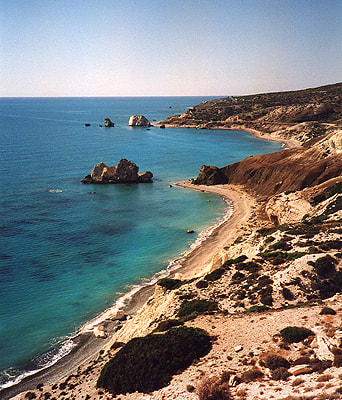 On this curved beach near the two distant rocks, a beautiful, naked woman rose from the sea foam. Flowers grew wherever she stepped. She brought joy and harmony, and sensual pleasure. Her name was Aphrodite. This is a part of the legend describing the birth of the Greek goddess of love and beauty on the western coast of Cyprus in the Mediterranean. Her role has come down to us as that of a licentious, vain, and powerful lover. But in Cyprus, she is much more than that. She is a symbol of wholeness and the union of the male and female principles, and she was identified with the fertility goddess Astarte. Her birth was a synthesis of opposites: out of violence and ugliness, she emerged as a bearer of love and beauty. (The myth goes like this: when Cronos, the youngest son of Uranus (Sky) and Gaia (Earth), hacked off the genitals of his father, the immortal penis fell into the sea and out of it Aphrodite grew.) Aphrodite was worshiped in many shrines on the island, but the main one was her temple in Palea Paphos. Her symbol was a conical omphalos (a navel stone). One of those has survived, blackened by centuries of libation with olive oil, and was in use until it was removed to the museum in Kouklia. Cyprus was my home for three years, and I swam many times around those rocks (the Cypriots believe you emerge more beautiful after swimming there!), and attended full moon meditations on the beach in honor of the Goddess, as Aphrodite is simply called in Cyprus. On a restaurant terrace up in the hills, I spent many afternoons with Dwight, silently watching sunsets that swept the sky on fire—the fire of love, it felt to me.
0 Comments
|
Overview
All
|
